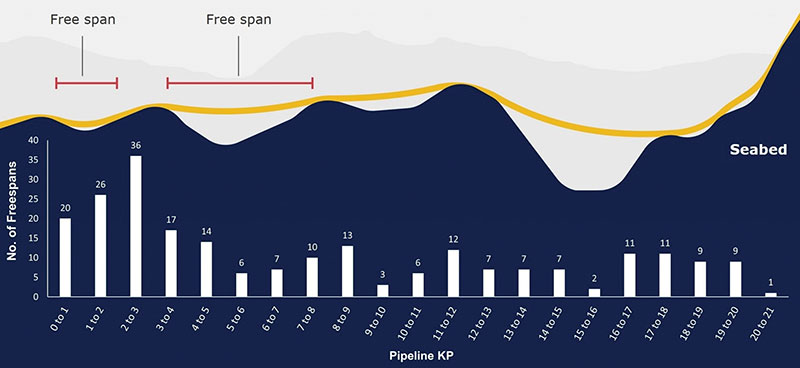April 2021, Vol. 248, No. 4
Features
CASE STUDY: Free Span Assessment of Subsea Pipelines
Special to Pipeline & Gas Journal
Free spans on subsea pipelines are caused mainly by seabed irregularities, scouring and other factors such as movement of the pipeline during operation or the installation of artificial supports.
Free spanning of subsea pipelines is a concern during both the installation and operational phase of the pipeline life and needs to be monitored to ensure the integrity of the pipeline.
Vortex-induced vibration (VIV) is one of the major sources of dynamic loads on free spanning pipelines. Because of the flow of wave and current around the free spanning pipeline, vortex shedding is generated.
When the vortex shedding coincides with the natural frequency of the span, it causes the pipeline to vibrate, either inline with the flow (inline VIV) or in perpendicular motion to the flow (crossflow VIV).
The stress caused by the resulting vibrations combined with the wave loading conditions can lead to a fatigue failure. Span lengths are thus required to be limited to ensure that the natural frequency for the span is greater than that of the vortex shedding.
It is vital that accurate analytical approaches are used to determine the maximum allowable span length, below which the onset of VIV is prevented. Regular monitoring also should be performed to ensure that spans in excess of the allowable limits are identified and addressed to ensure that the pipeline is operated within the acceptable risk levels.
Client Study
AIE performed a detailed free span assessment on a pipeline system in accordance with DNV-RP-F105. The assessment was performed on two subsea pipelines, an 11.6-mile (18.7-km), 12-inch infield pipeline and a 12.4-mile (20-km), 12-inch export pipeline. After a comprehensive remotely operated vehicle (ROV) pipeline inspection, the survey showed many free spans for both pipelines.
The infield pipeline had previously been assessed and a span rectification project was completed based on the original project environmental conditions. However, both ROV and diver experiences in the field differed from the reported environmental conditions, and a new metocean study was undertaken to confirm the conditions.
The new study showed that there was an increase in the seabed currents in the area when compared with the project data, likely to be attributed to the changing shape of the coastline due to coastal construction activities. Based on the revised metocean data, new allowable free span lengths were calculated based on DNV-RP-F105 screening criteria for a range of water depths along the pipeline.
The export pipeline’s existing allowable free span lengths were based on project documentation and were considered to be overly conservative, resulting in a large number of spans not passing the screening criteria. The allowable span length, therefore, was re-calculated by AIE to account for the operating conditions in the pipeline.
Using in-house engineering analysis software for free span screening and fatigue assessment based on DNV-RP-F105, the maximum allowable free span lengths for both pipelines were established based on code allowable limits for pipeline stress and screening criteria.
The following code compliance checks were undertaken in accordance with DNV-RP-F105:
- Static stress analysis under the combined action of current and waves
- Inline vibration under the combined action of current and waves
- Crossflow vibration under the combined action of current and waves
- Simplified fatigue damage
After incorporating the latest environmental data, the maximum allowable span limit was calculated for a series of zones along the pipeline route. An allowance was also made for the inspection tolerance in the calculation of the maximum allowable span length.
The pipeline zones were selected based on changes in water depth, wall thickness, concrete coating thickness or any other change in pipeline conditions that would impact the pipeline response.
Once the maximum allowable span length for each zone was calculated, all free spans were identified that exceeded these limits. The following table details the result of the assessment.
Following the screening assessment, AIE recommended that a detailed fatigue analysis for both pipelines be undertaken to further reduce the number of spans requiring rectification.
This would reduce the cost of the rectification campaign because the cost for additional desktop engineering is significantly cheaper than the cost of the rectification of unnecessary spans while maintaining the integrity of the pipelines. The client agreed to the recommendation and work commenced to undertake the detailed analysis of the spans.
All spans that exceeded the screening length criteria were subjected to a detailed fatigue assessment, accounting for specific conditions (water depth, concrete coating thickness and temperature) at each location.
Results of the assessment showed a significant decrease in the number of spans requiring rectification. The following table details the results before and after the screening and fatigue analysis.
Through detailed analytical means, AIE reduced the cost of the span rectification campaign significantly, without comprising the pipeline integrity and risk associated with the pipelines.






Comments